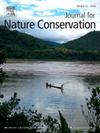IF 2.2
3区 环境科学与生态学
Q2 BIODIVERSITY CONSERVATION
引用次数: 0
摘要
本实证研究试图揭示红树林生态系统服务(ES)与当地社区福祉之间的复杂关系,强调这种联系对于实现可持续发展指标的重要性。红树林生态系统面临着来自工业发展和经济不稳定等挑战的风险。在伊朗,这些生态系统在支持当地社区的生计和福祉方面发挥着至关重要的作用,包括提供可食用的水产资源、蜂蜜生产和牲畜饲料。本研究旨在确定影响生态系统福祉和人类福祉(HWB)双重性的变量,以促进可持续发展承诺并支持当地社区的 HWB。为了更好地了解红树林生态系统服务对 HWB 的影响,研究人员采用了结构方程模型 (SEM) 和社会进步指数 (Social Progress Index),考察社区对这些服务的认知对其态度的影响。最终,本研究旨在通过结构化问卷澄清当地社区的环境服务与 HWB 之间关系的复杂性。从 45 个城市和农村居住区的 400 个家庭中收集了数据。总体而言,研究结果表明,红树林生态系统与 HWB 之间存在负相关关系,但也发现了对这些生态系统的积极看法,这与社区对红树林保护的良好态度有关。我们使用了 FIMIX 技术来揭示数据中隐藏的异质性,结果表明这种关系在不同地区存在差异,受到文化差异和对自然资源依赖性的影响。生计和对生态系统服务的认识等当地因素也对社区态度和行为的形成起着重要作用。我们的研究结果表明,管理计划应强调提高认识和与环境相容的经济发展,特别是通过为当地红树林产品创造附加值,从而同时提高红树林的可持续性和当地的 HWB。本文章由计算机程序翻译,如有差异,请以英文原文为准。
Mangrove forest ecosystem services and the social well-being of local communities: Unboxing a dilemma
This empirical study tries to reveal the complex relationship between mangrove ecosystem services (ESs) and the well-being of local communities, emphasizing the importance of this connection for achieving sustainability indicators. Mangrove ecosystems face risks from challenges such as industrial development and economic instability. In Iran, these ecosystems play a vital role in supporting the livelihoods and well-being of local communities, including the provision of edible aquatic resources, honey production, and fodder for livestock. This research seeks to identify the variables influencing the duality of ecosystem well-being and human well-being (HWB) to contribute to sustainability commitments and support the HWB of local communities. To better understand the effects of mangrove ESs on HWB, Structural Equation Modeling (SEM) and the Social Progress Index have been employed, examining the impact of community perceptions of these services on their attitudes. Ultimately, this research aims to clarify the complexities in the relationship between ESs-HWB of local communities through a structured questionnaire. Data were collected from 400 households across 45 urban and rural settlements. Overall, the results indicated a negative association between mangrove ESs and HWB, however, a positive perception of these ESs was find, which is linked to a favorable community attitude toward mangrove conservation. We used the FIMIX technique to revealed hidden heterogeneity in the data, and the results showed that this relationship varies across regions, influenced by cultural differences and dependence on natural resources. Local factors such as livelihoods and awareness of ESs also play a significant role in shaping community attitudes and behaviors. Our finding suggest that management programs should emphasize awareness-raising and environmentally compatible economic development, particularly through creating added value for local mangrove products, which simultaneously enhance mangrove sustainability and local HWB.
求助全文
通过发布文献求助,成功后即可免费获取论文全文。
去求助
来源期刊

Journal for Nature Conservation
环境科学-生态学
CiteScore
3.70
自引率
5.00%
发文量
151
审稿时长
7.9 weeks
期刊介绍:
The Journal for Nature Conservation addresses concepts, methods and techniques for nature conservation. This international and interdisciplinary journal encourages collaboration between scientists and practitioners, including the integration of biodiversity issues with social and economic concepts. Therefore, conceptual, technical and methodological papers, as well as reviews, research papers, and short communications are welcomed from a wide range of disciplines, including theoretical ecology, landscape ecology, restoration ecology, ecological modelling, and others, provided that there is a clear connection and immediate relevance to nature conservation.
Manuscripts without any immediate conservation context, such as inventories, distribution modelling, genetic studies, animal behaviour, plant physiology, will not be considered for this journal; though such data may be useful for conservationists and managers in the future, this is outside of the current scope of the journal.
 求助内容:
求助内容: 应助结果提醒方式:
应助结果提醒方式:


